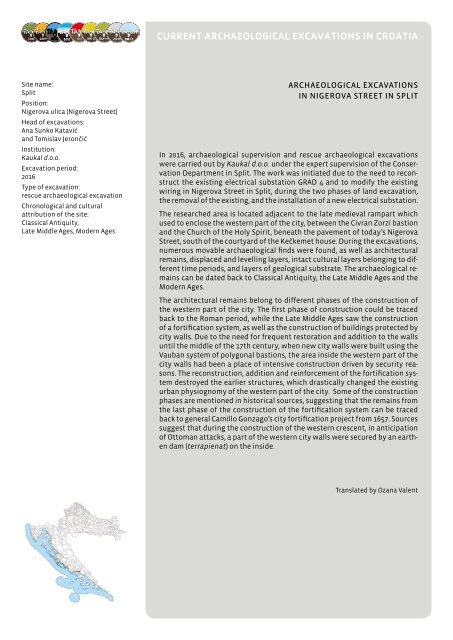AMZ_TAIUH_2017_ prijevodi na engleski
Create successful ePaper yourself
Turn your PDF publications into a flip-book with our unique Google optimized e-Paper software.
CURRENT ARCHAEOLOGICAL EXCAVATIONS IN CROATIA<br />
Site <strong>na</strong>me:<br />
Split<br />
Position:<br />
Nigerova ulica (Nigerova Street)<br />
Head of excavations:<br />
A<strong>na</strong> Sunko Katavić<br />
and Tomislav Jerončić<br />
Institution:<br />
Kaukal d.o.o.<br />
Excavation period:<br />
2016<br />
Type of excavation:<br />
rescue archaeological excavation<br />
Chronological and cultural<br />
attribution of the site:<br />
Classical Antiquity,<br />
Late Middle Ages, Modern Ages<br />
ARCHAEOLOGICAL EXCAVATIONS<br />
IN NIGEROVA STREET IN SPLIT<br />
In 2016, archaeological supervision and rescue archaeological excavations<br />
were carried out by Kaukal d.o.o. under the expert supervision of the Conservation<br />
Department in Split. The work was initiated due to the need to reconstruct<br />
the existing electrical substation GRAD 4 and to modify the existing<br />
wiring in Nigerova Street in Split, during the two phases of land excavation,<br />
the removal of the existing, and the installation of a new electrical substation.<br />
The researched area is located adjacent to the late medieval rampart which<br />
used to enclose the western part of the city, between the Civran Zorzi bastion<br />
and the Church of the Holy Spirit, beneath the pavement of today’s Nigerova<br />
Street, south of the courtyard of the Kečkemet house. During the excavations,<br />
numerous movable archaeological finds were found, as well as architectural<br />
remains, displaced and levelling layers, intact cultural layers belonging to different<br />
time periods, and layers of geological substrate. The archaeological remains<br />
can be dated back to Classical Antiquity, the Late Middle Ages and the<br />
Modern Ages.<br />
The architectural remains belong to different phases of the construction of<br />
the western part of the city. The first phase of construction could be traced<br />
back to the Roman period, while the Late Middle Ages saw the construction<br />
of a fortification system, as well as the construction of buildings protected by<br />
city walls. Due to the need for frequent restoration and addition to the walls<br />
until the middle of the 17th century, when new city walls were built using the<br />
Vauban system of polygo<strong>na</strong>l bastions, the area inside the western part of the<br />
city walls had been a place of intensive construction driven by security reasons.<br />
The reconstruction, addition and reinforcement of the fortification system<br />
destroyed the earlier structures, which drastically changed the existing<br />
urban physiognomy of the western part of the city. Some of the construction<br />
phases are mentioned in historical sources, suggesting that the remains from<br />
the last phase of the construction of the fortification system can be traced<br />
back to general Camillo Gonzago’s city fortification project from 1657. Sources<br />
suggest that during the construction of the western crescent, in anticipation<br />
of Ottoman attacks, a part of the western city walls were secured by an earthen<br />
dam (terrapie<strong>na</strong>t) on the inside.<br />
Translated by Oza<strong>na</strong> Valent


